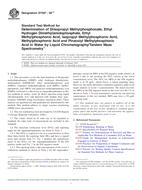Potrebujeme váš súhlas na využitie jednotlivých dát, aby sa vám okrem iného mohli ukazovať informácie týkajúce sa vašich záujmov. Súhlas udelíte kliknutím na tlačidlo „OK“.
ASTM D7597-09e2
Standard Test Method for Determination of Diisopropyl Methylphosphonate, Ethyl Hydrogen Dimethylamidophosphate, Ethyl Methylphosphonic Acid, Isopropyl Methylphosphonic Acid, Methylphosphonic Acid and Pinacolyl Methylphosphonic Acid in Water by Liquid Chro (Includes all amendments And changes 6/3/2016).
Automaticky preložený názov:
Štandardná skúšobná metóda pre stanovenie diisopropylesteru methylfosfonátu, etyl-vodíkové Dimethylamidophosphate, etyl kyseliny Methylphosphonic, izopropyl kyseliny Methylphosphonic, kyselina Methylphosphonic a Pinacolyl kyseliny Methylphosphonic vo vode Liquid CHRO
NORMA vydaná dňa 1.12.2009
Informácie o norme:
Označenie normy: ASTM D7597-09e2
Poznámka: NEPLATNÁ
Dátum vydania normy: 1.12.2009
Kód tovaru: NS-38796
Počet strán: 12
Približná hmotnosť: 36 g (0.08 libier)
Krajina: Americká technická norma
Kategória: Technické normy ASTM
Kategórie - podobné normy:
Anotácia textu normy ASTM D7597-09e2 :
Keywords:
liquid chromatography, mass spectrometry, organophosphonates, ICS Number Code 13.060.50 (Examination of water for chemical substances)
Doplňujúce informácie
| Significance and Use | ||||||||||||||||
|
Organophosphate pesticides affect the nervous system by disrupting the enzyme that regulates acetylcholine, a neurotransmitter. They were developed during the early 19th century, but their effects on insects, which are similar to their effects on humans, were discovered in 1932. Some are poisonous and were used as chemical weapon agents. Organophosphate pesticides are usually not persistent in the environment. , This test method is for the analysis of selected organophosphorous-based chemical weapon agent degradation products from Sarin (GB), Soman (GD), Tabun (GA) and VX. This method has been investigated for use with reagent and surface water. |
||||||||||||||||
| 1. Scope | ||||||||||||||||
|
1.1 This procedure covers the determination of diisopropyl methylphosphonate (DIMP), ethyl hydrogen dimethylamidophosphate (EHDMAP), ethyl methylphosphonic acid (EMPA), isopropyl methylphosphonic acid (IMPA), methylphosphonic acid (MPA) and pinacolyl methylphosphonic acid (PMPA) (referred to collectively as organophosphonates in this test method) in surface water by direct injection using liquid chromatography (LC) and detected with tandem mass spectrometry (MS/MS) using electrospray ionization (ESI). These analytes are qualitatively and quantitatively determined by this method. This method adheres to single reaction monitoring (SRM) mass spectrometry. 1.2 This test method has been developed in support of the National Homeland Security Research Center, US EPA by Region 5 Chicago Regional Laboratory. 1.3 The values stated in SI units are to be regarded as standard. No other units of measurement are included in this standard. 1.4 The detection verification level (DVL) and reporting range for the organophosphonates are listed in Table 1. 1.4.1 The DVL is required to be at a concentration at least three times below the reporting limit (RL) and have a signal/noise ratio greater than 3:1. Fig. 1 displays the signal/noise ratios at the DVLs for the organophosphonates in the ESI positive mode and Fig. 2 in the ESI negative mode. 1.4.2 The reporting limit is the concentration of the Level 1 calibration standard as shown in Table 2 for the organophosphonates except for MPA in the ESI negative mode which is at Level 2 due to not meeting the DVL criteria at the lower concentration level. The DVL for MPA in the ESI negative mode is at 20 μg/L, which forces a raised reporting limit. However, the multi-laboratory validation required a spike of all target analytes at Level 1 concentrations. The mean recovery for MPA in the ESI negative mode at this level was 98.7 % as shown in Table 3. If your instrument’s sensitivity can meet the requirements in this test method, MPA may have a 50 μg/L reporting limit. 1.5 This standard does not purport to address all of the safety concerns, if any, associated with its use. It is the responsibility of the user of this standard to establish appropriate safety and health practices and determine the applicability of regulatory limitations prior to use. |
||||||||||||||||
| 2. Referenced Documents | ||||||||||||||||
|
Odporúčame:
Aktualizácia technických noriem
Chcete mať istotu, že používate len platné technické normy?
Ponúkame Vám riešenie, ktoré Vám zaistí mesačný prehľad o aktuálnosti noriem, ktoré používate.
Chcete vedieť viac informácií ? Pozrite sa na túto stránku.




 Cookies
Cookies
